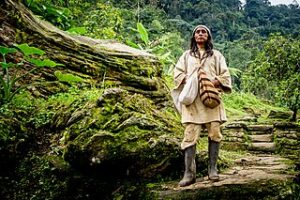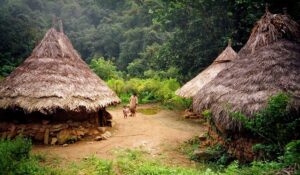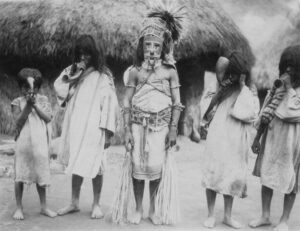The Ethnological Museum of Berlin has officially handed back two wooden sacred masks belonging to the Kogi (Cogui or Kágaba, meaning cougar) people, an indigenous community descended from the pre-Columbian Tairona culture who live in the highlands of the Sierra Navada de Santa Marta in present day Colombia.

Kogi shaman, Ciudad Perdida, Colombia. Photo Dwayne Reilander, 3/23/2017, CCA-SA 4.0
According to the Prussian Cultural Heritage Foundation, the masks are sacred and should never have been acquired; the terms of their future use is said to be in the hands of the Kogi people, not the Colombian government. The masks were delivered by German President Frank-Walter Steinmeier to Colombia’s President, Gustavo Petro on June 16.
The masks are known as “Sun Mask” (Mama Uakai) and “Great Sun Mask” (Mama Nuikukui Uaka). They are estimated to be about 600 years old. The two masks were purchased from the son of a deceased Kogi priest for the museum by German ethnologist Konrad Theodor Preuss, among with some 700 other objects acquired during his journeys in Colombia in 1915. While they have now been treated in order to remove the toxins as much as is possible, curators at the Berlin museum expressed concerns that the masks would not be safe to use because they have been heavily treated with pesticides in order to preserve them from insect damage. Kogi representatives have welcomed the return and said that they intend to use the masks in traditional rituals.

Kogi habitations, Thomas Dahlberg, October 2004, CCA-SA 3.0 unported license.
The Kogi believe that their traditions enable them to live on mother earth, which they consider a living being, in balance with nature as ‘Elder Brothers’ whose lifestyle sustains and preserves the earth’s ecology.
With the exception of twice allowing a BBC film crew to come to record their beliefs and way of life in order to inform the rest of the world, the Kogi do not generally allow outsiders to enter their lands. In these films, they try to show their “Younger Brothers” in the outside world the harm that they are doing to earth through exploitation and devastation of its resources.[1]

Hiséi-mask wearer, Kogi people, Photo Konrad Theodor Preuss, 1914.
The Kogi religion is complex, and various aspects of life are seen as natural opposites through which balance is achieved. Traditional priests, mamos, undergo a lengthy period of training in concentration and divination; selected infant boys are raised by their mothers and priests in a dark cave until they are nine, and ready to encounter the world. The Kogi live by slash and burn agriculture in villages centered around a sacred mountain, planting a variety of crops and raising some cattle. They greatly value the benefits of coca leaves, which men chew throughout the day.
[1] The first film, by Alan Ereira, is the 1990 From the Heart of The World: Elder Brother’s Warning. The second is the 2012 film Aluna.
 Kogis and tourists on Arrecifes Beach, detail, Two cultures in the same place in Tairona, Colombia. Photo by Rochy Hernandez, 14 January 2023, CCA-SA 4.0 International license.
Kogis and tourists on Arrecifes Beach, detail, Two cultures in the same place in Tairona, Colombia. Photo by Rochy Hernandez, 14 January 2023, CCA-SA 4.0 International license. 

